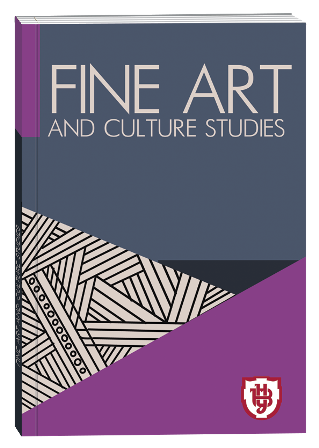ФОРТЕПІАННІ БАЛАДИ ЧЖАО СЯОШЕНА ЯК МУЗИЧНІ АРТЕФАКТИ ЕПОХИ КУЛЬТУРНОЇ РЕВОЛЮЦІЇ В КИТАЇ
DOI:
https://doi.org/10.32782/facs-2025-3-1-7Ключові слова:
фортепіанна балада, композитор, жанрово-стильові особливості, музичний твір, національні риси, амбівалентність, КитайАнотація
Мета статті полягає в осмисленні фортепіанних балад Чжао Сяошена як музичних артефактів періоду Культурної революції (1966–1976), що відображають політичну амбівалентність, естетичний спротив, особисту травму та культурну пам’ять у межах офіційно дозволеного художнього висловлювання. Дослідження спрямоване на виявлення культурно-політичного контексту створення цих творів, а також їх жанрово-стильових особливостей. Методологія. У статті використано історико-контекстуальний метод для з’ясування соціополітичних умов Культурної революції та їхнього впливу на музичне середовище. Жанрово-стильовий аналіз спрямований на розгляд балади як синтетичної форми, що поєднує європейську баладну структуру та китайські формотворчі моделі (зокрема qi–cheng–zhuan–he). Інтерпретативний підхід дав змогу виявити символічний зміст, алюзії та риторичні стратегії музичного висловлення, пов’язані з темами травми, втрати та внутрішнього спротиву.Наукова новизна. Уперше фортепіанні балади Чжао Сяошена розглянуто як семантично глибокі музичні тексти епохи Культурної революції, в яких художня мова стає засобом збереження творчої ідентичності в умовах політичної цензури. Запропоновано інтерпретацію Балади Des-dur як алюзійного музичного монументу пам’яті репресованого покоління, а Балади D Gong як стилістичну відповідь на звинувачення в західному впливі.Висновки. Обидві балади репрезентують складну емоційну та ідеологічну амбівалентність: поєднання лояльної зовнішньої форми та внутрішнього протесту. Музика Чжао Сяошена постає як форма прихованого опору, в якій жанрово-стильові засоби виконують функцію культурної пам’яті. Твори композитора свідчать про трансформацію фортепіанного мистецтва Китаю під впливом політичних обставин та особистої трагедії.
Посилання
Kang, Le. The Development of Chinese Piano Music. Asian Culture and History. 2009. Vol. 1. No. 2. P. 18–33.
Kraus, Richard Curt. Pianos and Politics in China: Middle-Class Ambitions and the Struggle over Western Music. New York and Oxford: Oxford University Press, 1989.
Lee, Hong-Yung. The Politics of the Chinese Cultural Revolution: A Case Study. Berkeley : University of California Press, 1978. DOI: https://doi.org/10.2307/jj.13167968
Lek, Hor Tan. Fou Tsong: I Wept for China. Index on Censorship. 2007. Vol. 8. No. 89. P. 19–27.
Liang, Xinyi. Piano Transcriptions of Chinese Traditional Music from the Cultural Revolution Period: Political Constraints, Artistic Freedom and Implications for Performance. 2002. Master’s thesis. The University of Sheffield.
Liu, Ching-Chih. A Critical History of New Music in China. Hong Kong : The Chinese Uni-versity Press, 2010.
Mei, X. Organization and wisdom: The essence of music creation – An interview with Zhao Xiaosheng. Yuefu Xinsheng. 2003. Vol. 4. P. 20–23.
Melvin, Sheila, and Cai Jindong. Rhapsody in Red: How Western Classical Music Became Chinese. New York : Algora Publishing, 2004.
Xue, Ke, Loo, Fung, Ying, Loo, Fung, Chiat, & Wang, Xiaohang. Cultural Revolution and Political Ambivalence in Zhao Xiaosheng’s Two Ballades for Piano Solo. Muzikološki zbornik. 2021. LVII (1). P. 149–175. DOI: https://doi.org/ 10.4312/mz.57.1.149-175
Xue, K., Loo, F. Y., Chiat L., & Wang, X. (2023). Zhao Xiaosheng’s Tai Chi:: Re-visiting the Meaning and Accretion of I Ching in the Contemporaneity of Chinese Music Semantics. Música Hodie. Vol. 23. DOI: https://doi.org/10.5216/ mh.v23.75844
Xue, Ke & Loo, Fung Ying. A Stylistic Analysis of Zhao Xiaosheng’s Piano Ballades. Musicological Annual. 2021. Vol. 57. No. 2. Р. 61–77.
Zhao, X., & Mei, X. My musical faith: Conversations with Zhao Xiaosheng. Shanghai Conservatory of Music Press. 2012.
##submission.downloads##
Опубліковано
Як цитувати
Номер
Розділ
Ліцензія

Ця робота ліцензується відповідно до Creative Commons Attribution 4.0 International License.







